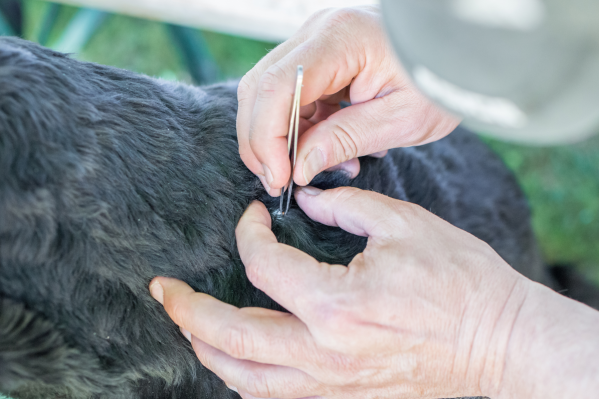After a leisurely hike with your canine companion, you notice a small black lump peeking out from their skin. Perhaps your pup keeps scratching the area or doesn't notice it at all, but after a quick image search, you're pretty positive it's a tick.
"Some dogs may be itchy and scratch or chew an area where ticks may have latched on, but oftentimes they are asymptomatic and it is usually the pet parents that notice them as dark round lumps," explains Dr. Yui Shapard, BVM&S, MRCVS and medical director at Pawp. "The areas where ticks most often latch onto are the limbs, chest, belly, armpits, and ears."
Ticks bite both animals and people and pass along bacteria, viruses, and other parasites, so it's important to know what to do next if your dog gets bitten by a tick. We spoke with Dr. Shapard to learn how to remove a tick from a dog safely and how to prevent ticks in the future.
How to remove a tick from a dog
If your dog has a tick, the first thing you should do is consult a vet.
"We generally don't recommend pet parents remove ticks on their own since it takes some practice and skill to make sure that you remove the entire tick, including the head," explains Dr. Shapard. "When not removed properly, the head of the tick may remain on the skin. This can cause additional complications surrounding that area since you are essentially leaving a foreign object (the tick head) in the dog's skin. Irritation, redness, granulomas, and skin infections can potentially arise and will lead to additional veterinary intervention to appropriately treat this complication."
If taking your dog to the vet is not an option at that moment, then Dr. Shapard recommends using a special tick remover rather than a tweezer. Slide it underneath the tick, rotate it several times, and then gently remove the tick to make sure you're not just removing the body and leaving the head behind. This video explains this process well.
Once the tick has been removed, contact your dog's primary veterinarian and schedule blood work to check for tick-borne diseases. Ticks carry bacterial diseases called Lyme, Erlichia, and Anaplasmosis. It can take several weeks for this blood work to show any signs of possible exposure, so there's no need to rush in as long as the dog is asymptomatic and otherwise doing well.
"It would still be a good idea to let your veterinarian know so that a recommendation can be made that is specific to the individual needs of the dog," says Dr. Shapard. "For example, dogs with compromised kidney function may be more at risk of what is called a Lyme nephritis, so we would want to monitor their kidney function more closely in those cases, and the primary veterinarian may recommend a urine test to monitor their kidney functions."
Ultimately, what tests are best very much depends on each individual patient, and their veterinarian will know what to recommend and when to safely take a wait and see approach.
How to prevent ticks on dogs
It's impossible to 100% prevent your dog from getting ticks, but there are several steps to certainly offset the risks:
1. Use a tick repellent product that is safe to apply on dogs—this will help as a physical barrier.
2. Avoid or try to decrease the frequency of your dog accessing heavily shrubby areas.
2. Make sure your dog is on a tick preventative—an oral or topical solution will be effective. This won't 100% prevent them from latching on to your dog, but it will significantly reduce the risk of tick-borne disease being transferred into their blood circulation.
3. Use a flea and tick shampoo to kill any possible ticks that may still be alive.
4. Keep your dog up to date on their Lyme vaccine. Prevention is always better than treatment, and having them up to date on the Lyme vaccine provides you with the peace of mind that even if your dog is exposed to a live tick, the chance that they will develop Lyme disease will be significantly low compared to those that are not vaccinated.
If you have any questions about how to remove a tick from a dog or what your best next step for treatment should be, reach out to the experts at Pawp—we're here to help 24/7.
